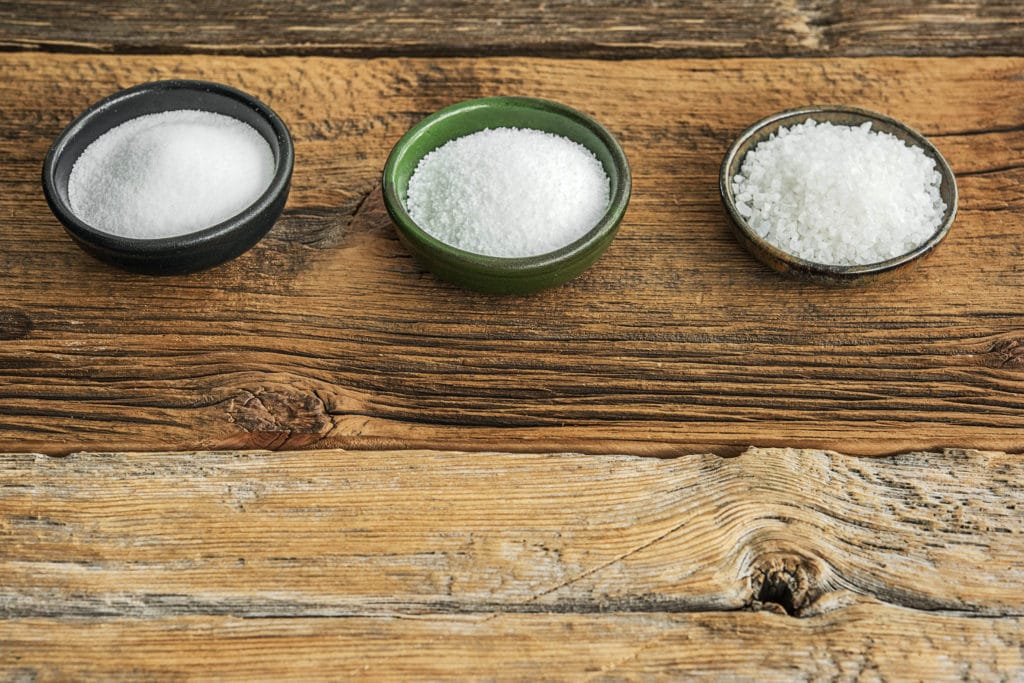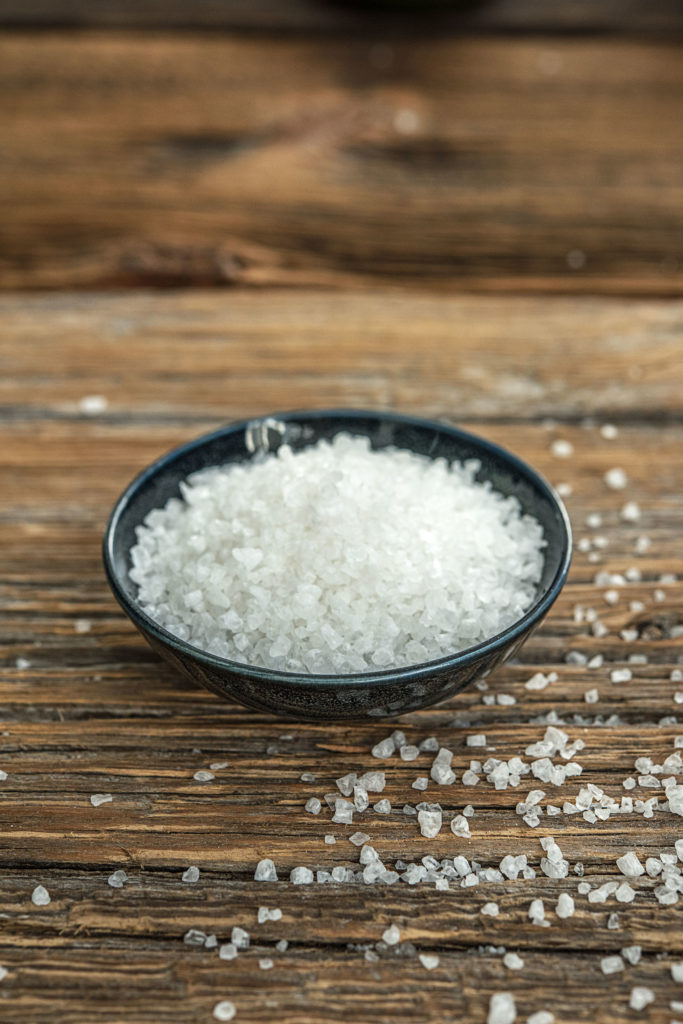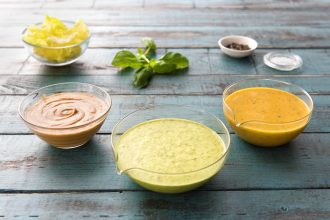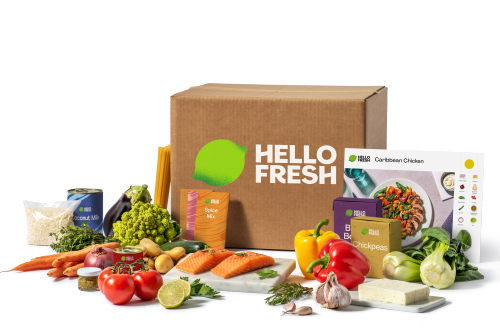3 Types of Salt You Should Have In Your Pantry (+how to use them) November 3, 2017
Does it really matter which type of salt you use when the sheer variety available is as wide as the sea? The short answer is yes, it does. Read on to find out why.
Season with salt and pepper. If you’ve ever cooked a HelloFresh meal, you’re probably familiar with this phrase. You’ll find it in every single one of our recipes—sometimes three, four, or five times. With so much seasoning going on, you’d think that our chefs are hooked up to a dispenser that shoots out salt and pepper at the flick of a wrist (they’re not, although that would be pretty cool).
Seasoning may seem like an afterthought compared to the (often literal) meat and potatoes of a meal. But it’s really the simplest and most fundamental way in which you can develop flavors. A pinch of salt and pepper here and there can mean the difference between food that’s bland and food that makes your taste buds sing and dance.
This is hardly groundbreaking advice. But if you’ve taken a trip down a grocery aisle lately, you’ve probably noticed that there are more types of salt than any collection of shakers could hold. You’ve got everything from your classic fine white table variety to craggy pink nuggets that look like they belong in a rare gem display. How’s a happy home cook to choose when the options are enough to induce a seasoning anxiety disorder?
Before you throw your hands up and pick the first container within reach, let’s establish that it does matter what salt you use when cooking and how you use it. If that has you scrambling to check your cabinet, fret not. There’s a time and place for every type. You’ve just got to know when and how to use each in a way that’s, well, worth its salt. (As for salt’s best friend pepper, we’ll visit him another day.)
What is salt?
Salt is the thing that makes foods salty, of course. But it’s also a mineral, an essential nutrient, and what happens when a sodium and a chlorine ion join together. That’s true of any type of salt, whether it’s in a fancy jar or in a paper packet from your neighborhood fast food joint.
If all salt is made from the same stuff, then why does it matter which kind I use?
Sure, at its most basic, salt is little more than good ol’ NaCl, regardless of how gussied up it is. But because different types of salt have different crystal structures, they each lend themselves to different uses.
Let’s back up a step and understand how those structural differences occur. There are two major sources of salt: sea water and inland salt deposits, from which salt is extracted by dissolving it in water. To turn either into edible salt, the water must be evaporated off. If this evaporation occurs rapidly, you’ll get very fine, uniform particles, like table salt. If it’s done slowly, coarse, flaky, and irregular shapes will form, like they do in many fancy sea salts.
The size and shape of salt crystals matters because it affects how much salt will fit in a given amount of space. If you measure out a teaspoon of fine table salt, all of the grains will fit pretty snugly with very little space between each. Do the same with a coarse sea salt and they’ll lie on top of each other like crumpled pieces of paper, unevenly distributed with lots of gaps in between. Thus, a teaspoon of table salt is actually saltier than a teaspoon of coarse sea salt because more of it fits in the same amount of space,
Some recipes will recommend a specific type and amount of salt to use to help guide you toward a certain level of saltiness. But others (including HelloFresh recipes) leave it up to you to season as you like. This is not just to make the recipe open-ended enough to accommodate any cook’s pantry. It’s also because everyone’s taste for the stuff is different. Factors like genetics, past experience, and even age can affect how you perceive it. Which is why there’s no one size fits all approach to seasoning—it’s personal.
But even if salt preferences are as unique to each person as their fingerprints, there are still a few rules you can follow that will help you use it wisely. Here’s a breakdown of the differences between table, kosher, and sea salt—the three basic types used for cooking—and when and where it’s best to break out each.
1. Kosher Salt
What it looks like: Coarse, medium-sized particles.
How to use it: Kosher salt is great for seasoning before, during, and after cooking. It’s preferred by many chefs as an all-purpose salt because its rough texture is easy to grip with the fingers, making it easier to control and dispense. The size of kosher salt crystals varies by brand, however, so it’s still a good idea to taste as you season, even when a recipe tells you how much of it to use. Kosher salt gets its name from the act of koshering, or removing impurities from meat after butchering according to Jewish dietary practice, thus it is perceived as having a cleaner taste and fewer additives (although, again, this can vary).
Where to use it: Our classic Meatloaf à la Mom is the perfect place for practicing your seasoning skills at every stage, especially with kosher salt.
2. Table Salt
What it looks like: Very fine, powdery, evenly-sized crystals.
How to use it: Table salt’s small, evenly-sized crystals are best suited for when you need to be precise in the amount of salt you’re measuring, particularly when baking. It also works just fine during cooking—since it dissolves easily, it blends right in to just about anything. And there’s certainly nothing stopping you from using it to season the food on your plate (it is called table salt, after all). It’s just that coarser salts are preferred by some for this task because they’re easier to control and bring some textural benefits.
If you’re going to use it, keep in mind that it’s easy to over-salt with table salt. Table salt is roughly twice as salty as the same volume of kosher salt (so measure out half if using the former in place of the latter). It’s also worth noting that table salt is sometimes iodized (fortified with potassium iodide, a dietary supplement), or treated with anticaking additives, which can create bitter or off flavors.
Where to use it: Our Lemon Ricotta Pancakes call for precise measuring to ensure that they’re perfectly light and fluffy, which is why you should break out the table salt when making them.
3. Sea Salt
What it looks like: Depending on how it’s harvested, sea salt comes in everything from fine crystals to huge chunks in a rainbow of shades.
How to use it: Sea salts are best used for finishing and seasoning foods after cooking. Because they’re often flaky and coarse, it’s difficult to measure them out consistently and get a sense of how much saltiness they’ll add. But that irregular texture translates into small, tasty bursts of deliciousness that can enhance a dish when used as a finishing touch. Meats, salads, roasted veggies, and even desserts can benefit from a light sprinkling. Sea salts also sometimes contain trace amounts of minerals or other organic materials from the waters they’re sourced from, creating additional flavor complexities (although you’d have to be a pretty advanced supertaster to notice).
Where to use it: A dash of sea salt is just the accent needed to finish off the fries and steak in our Strip Steak and Truffle Frites (bonus points for using a French sea salt in this bistro dish).
No matter which type of salt you’re using or what purpose it’s for, one rule always applies: keep it close as you’re cooking. If you remember to taste and season along the way, your food will be better, guaranteed.
For more wisdom on all things seasoning, check out:














